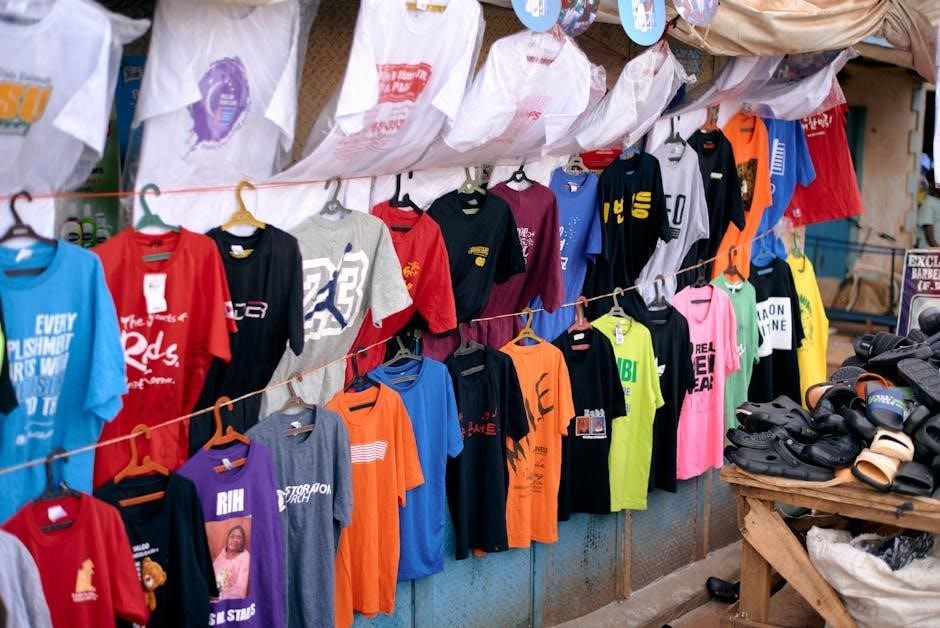PDF clothing patterns offer a convenient and accessible way to create custom garments․ Downloadable instantly, these patterns utilize software like Adobe Acrobat Reader for viewing and printing․
What are PDF Clothing Patterns?
PDF clothing patterns are digital sewing templates delivered as Portable Document Format (PDF) files․ Unlike traditional paper patterns, they aren’t pre-printed; instead, you download the file and print it yourself at home or a local print shop․ These patterns contain all the necessary pieces – front, back, sleeves, etc․ – laid out on one or more pages․

They often come in various sizes within a single file, eliminating the need to purchase multiple patterns for different measurements․ Software like Adobe Acrobat Reader is essential for viewing and accurately printing these files, ensuring the pattern pieces are the correct size for your project․ They represent a modern, flexible approach to sewing․

Why Use PDF Patterns?
PDF patterns offer numerous advantages for sewists․ Their immediate availability eliminates shipping costs and waiting times – download and start sewing instantly! They are incredibly cost-effective, often cheaper than their paper counterparts․ Plus, PDF patterns are space-saving; no bulky pattern envelopes to store․
A significant benefit is size inclusivity․ Many patterns include a wide range of sizes within a single file, simplifying the process․ You can also easily reprint specific sizes as needed․ Utilizing software like Adobe Acrobat Reader allows for precise printing, crucial for accurate garment construction․ They empower creative flexibility and accessibility․
Sourcing PDF Clothing Patterns
PDF clothing patterns are readily available through online marketplaces, independent designer websites, and free resource platforms, offering diverse styles and skill levels․
Online Marketplaces for PDF Patterns
Numerous online marketplaces specialize in PDF clothing patterns, providing a vast selection from various designers․ Etsy is a popular choice, boasting a huge collection of independent pattern designers offering unique and trendy styles․
Additionally, platforms like LoveCrafts and Makerist curate collections of patterns, often with sales and promotions․ These marketplaces frequently categorize patterns by garment type, skill level, and size range, simplifying the search process․
Many offer customer reviews and pattern testing photos, aiding in informed purchasing decisions․ Remember to check the pattern’s file format and printing requirements before buying!
Independent Designer Websites
Many talented designers maintain their own websites dedicated to PDF clothing patterns․ This allows for a direct relationship with the creator and often provides more detailed pattern instructions and support․ These sites frequently showcase the designer’s unique aesthetic and brand․
Examples include Helen’s Closet Patterns, known for inclusive sizing and modern designs, and Tilly and the Buttons, offering beginner-friendly patterns with comprehensive tutorials․
Directly purchasing from designers often supports their work more effectively and may unlock exclusive content or early access to new releases․ Explore Instagram and sewing blogs to discover hidden gems!
Free PDF Pattern Resources
Numerous online platforms offer free PDF clothing patterns, perfect for beginners or those wanting to test a design before purchasing․ While quality varies, these resources provide excellent opportunities to build sewing skills without significant investment․
Websites like So Sew Easy and Mood Fabrics frequently release free patterns, often focusing on simple garments or accessories․ Pinterest is also a treasure trove, linking to various free pattern downloads․
Remember to carefully review instructions and pattern pieces, as free patterns may have less detailed documentation than paid options․

Understanding PDF Pattern Files
PDF pattern files require software like Adobe Acrobat Reader to open and print correctly․ They come in various formats – A4, Letter, or tile print – impacting preparation․
Types of PDF Pattern Files (A4, Letter, Tile Print)
PDF patterns are distributed in formats tailored to common paper sizes․ A4 patterns are designed for the standard European paper size, while Letter patterns suit US and Canadian printers․ Choosing the correct size is crucial for accurate printing and pattern piece dimensions․
However, some patterns, especially complex ones, are delivered as tile print files․ These are split into multiple pages that must be assembled like a puzzle before cutting․ This method allows for larger pattern pieces than a single sheet of paper can accommodate․ Accurate alignment during assembly is vital for a correctly fitting garment, ensuring all pieces match seamlessly․
Required Software: Adobe Acrobat Reader
To effectively utilize PDF clothing patterns, you’ll need software capable of opening and printing them correctly․ Adobe Acrobat Reader is the industry standard and is freely available for Windows, Mac OS, and Android devices․ It allows you to view, print, and even add comments to the pattern files․
While other PDF viewers exist, Acrobat Reader ensures accurate scaling and printing, essential for pattern accuracy․ Downloading and installing this software is the first step in your PDF sewing journey, enabling you to access and prepare your patterns for cutting and construction․ It’s a fundamental tool for any sewist!
Printing PDF Patterns Accurately
Accurate printing is crucial when working with PDF clothing patterns․ Always select “Actual Size” or “100% Scale” in your printer settings to avoid distortion․ Before printing the entire pattern, print the test square (usually a 1-inch square) included in the PDF file and measure it․ If it doesn’t measure exactly one inch, adjust your scaling accordingly․
Incorrect scaling will result in garments that don’t fit properly․ Ensure your printer is calibrated and using quality paper for best results․ Double-check these settings before committing to printing the full pattern – a little precision saves a lot of frustration!
Working with Printed PDF Patterns
Printed PDF patterns often require assembly via taping or gluing tiled pages together․ Understanding pattern markings and symbols is key for accurate fabric cutting․
Assembling Tiled Patterns
Many PDF clothing patterns are delivered as multiple pages designed to be printed on standard letter or A4 paper, creating a “tiled” pattern․ This method allows for larger pattern pieces to be accommodated within typical printer sizes․ Carefully align the registration marks – small symbols printed on each page – to ensure accurate assembly․
Use a glue stick or pattern tape to join the pages, overlapping the lines precisely․ Take your time; accuracy at this stage is crucial for a well-fitting garment․ Lay the assembled pattern pieces flat under weights to prevent shifting while you trace or cut․ Double-check all seams and curves for smooth transitions after assembly․
Understanding Pattern Markings and Symbols
PDF clothing patterns utilize a standardized system of markings and symbols to guide the sewist․ Grainlines indicate how to align the pattern piece with the fabric’s weave․ Notches help match corresponding pieces during construction, ensuring accurate seams․ Darts are marked with triangular shapes, defining shaping in the garment․
Symbols denote buttonholes, pocket placements, and fold lines․ Understanding these markings is vital for successful sewing․ Refer to the pattern’s key or legend for a complete explanation of all symbols used․ Ignoring these details can lead to misaligned pieces and a poorly fitted final product․

Cutting Fabric with PDF Patterns
Cutting fabric accurately is crucial when using PDF clothing patterns․ After printing and assembling, lay the pattern pieces onto your chosen fabric, paying close attention to the grainline; Secure the pattern with pattern weights or pins․ A rotary cutter and cutting mat offer precision, but sharp fabric scissors are also suitable․
Cut along the pattern lines, ensuring smooth, clean edges․ Add seam allowances as indicated in the pattern instructions – typically 5/8 inch․ Double-check that you’ve cut the correct number of pieces for each pattern part before proceeding․ Accurate cutting sets the foundation for a well-constructed garment․

Essential Tools for Sewing PDF Patterns
Successful PDF sewing requires specific tools: a rotary cutter, cutting mat, clear ruler, and tracing paper for accurate pattern preparation and fabric cutting․

Rotary Cutter and Mat
A rotary cutter is arguably the most crucial tool when working with PDF patterns, offering precision far exceeding traditional scissors․ When paired with a self-healing cutting mat, it provides a safe and reliable surface for clean, accurate cuts through multiple pattern pieces simultaneously․
Investing in a quality rotary cutter with a comfortable grip is essential, as you’ll be using it extensively․ Different blade sizes are available; a 45mm blade is versatile for most fabrics․ The cutting mat protects your work surface and extends the life of your blades․ Regularly check and replace blades to maintain sharpness and prevent fabric snagging, ensuring professional-looking results with your PDF-sewn creations;
Clear Ruler
A clear acrylic ruler is indispensable for accurately tracing pattern pieces and adding seam allowances when working with PDF clothing patterns․ Unlike opaque rulers, a clear ruler allows you to see the pattern lines beneath, ensuring precise placement for marking and cutting․
Look for a ruler with clear, bold markings in both inches and centimeters for versatility․ A longer ruler (18 inches or more) is helpful for straight lines, while a smaller square ruler aids in marking perpendicular angles․ Using a clear ruler minimizes errors and contributes to a professional finish when constructing garments from downloaded PDF patterns․
Tracing Paper
Tracing paper is crucial when working with PDF clothing patterns, as it allows you to preserve the original pattern for future use or different sizes․ Instead of cutting directly into the printed PDF pattern, trace the desired size onto tracing paper․
This protects the original from wear and tear, and enables you to make alterations without damaging the master copy․ Choose a lightweight tracing paper that’s transparent enough to clearly see the pattern lines․ It’s an essential investment for serious PDF pattern sewers, promoting pattern longevity and flexibility․

Modifying and Grading PDF Patterns
PDF patterns can be adjusted for a perfect fit! Alter length and width, or grade between sizes to achieve personalized garments tailored to your unique measurements․
Basic Pattern Adjustments (Length, Width)
Adjusting PDF clothing patterns for length and width is fundamental for achieving a well-fitting garment․ Lengthening or shortening patterns is often done parallel to the grainline, typically at designated “lengthen/shorten” lines․ For width adjustments, consider easing or adding fullness; slash and spread the pattern piece, ensuring smooth transitions․
Small adjustments can dramatically improve fit․ Remember to maintain consistent alterations across corresponding pattern pieces – front and back bodices, for example․ Accurate measurements are crucial before making any changes․ Always test adjustments with a muslin (test garment) before cutting into your final fabric․ This prevents costly mistakes and ensures a satisfying sewing experience․
Grading Patterns for Different Sizes
Grading PDF clothing patterns involves scaling the pattern up or down to achieve different sizes․ This isn’t simply a uniform percentage increase or decrease; it requires understanding grading rules, which vary depending on the garment’s design and fit․ Typically, grading involves adjusting key measurements – bust, waist, hips – proportionally․
Software can assist with precise grading, but manual grading is also possible using a ruler and French curves․ It’s vital to maintain the original design’s shape and proportions during the process․ Always grade all pattern pieces consistently and create a muslin to verify the fit before cutting your fashion fabric․

Specific Clothing Types & PDF Patterns
PDF patterns cater to diverse clothing needs, including women’s wear, children’s styles, and accessories like bags and hats, offering varied designs and skill levels․
PDF Patterns for Women’s Clothing
PDF patterns unlock a vast wardrobe potential for women, ranging from everyday basics to sophisticated designs․ You’ll discover patterns for dresses – think flowing summer frocks or elegant evening gowns – alongside options for skirts, blouses, and tailored trousers․
Many designers specialize in women’s wear, offering patterns with detailed instructions and size inclusivity․ Explore options for outerwear like jackets and coats, or delve into lingerie and swimwear patterns for more advanced projects․ The availability of PDF clothing patterns means finding unique styles and achieving a perfect fit is easier than ever, allowing for personalized fashion creations․
PDF Patterns for Children’s Clothing
PDF patterns are incredibly popular for creating adorable and practical clothing for children․ From playful dresses and comfy rompers to durable pants and cozy sweaters, the options are endless․ Many patterns cater to various skill levels, making it accessible for both beginner and experienced sewists․
You can find patterns for babies, toddlers, and older children, often with features like adjustable waistbands and easy closures․ Creating handmade PDF clothing allows for unique designs and ensures a comfortable fit for growing kids, plus you can choose fabrics that are gentle on sensitive skin!
PDF Patterns for Accessories (Bags, Hats)
PDF patterns extend beyond garments, offering a fantastic range of accessory projects! Create stylish and functional bags – from simple totes and pouches to more complex backpacks and crossbody designs – using downloadable patterns․ Hats are another popular choice, with patterns available for beanies, sun hats, and even whimsical character designs․
These PDF clothing-adjacent projects are often quicker to sew than full garments, making them perfect for beginners or for adding a personalized touch to your wardrobe․ Explore patterns utilizing various fabrics and embellishments to express your creativity!

Troubleshooting Common Issues
PDF clothing patterns can sometimes present challenges․ Common problems include mismatched pattern pieces or incorrect print scaling, requiring careful attention to detail and re-printing․
Pattern Pieces Not Matching
PDF clothing pattern pieces failing to align correctly is a frequent frustration for sewists․ This often stems from inaccurate printing, where the scale isn’t maintained throughout the document․ Always double-check the test square after printing to ensure it measures precisely as indicated on the pattern․
Another cause can be improper assembly of tiled patterns; ensure each tile is aligned perfectly before taping them together․ Carefully review pattern instructions for specific matching points and markings․ If discrepancies persist, consider re-downloading the pattern file to rule out corruption, and reprint with adjusted printer settings․
Incorrect Print Scale
PDF clothing patterns absolutely require accurate printing to ensure garment fit․ An incorrect print scale is the most common issue encountered․ Patterns include a test square – a one-inch (or specified size) square – that must be measured after printing․ If it doesn’t measure correctly, adjust your printer settings․
Disable “Fit to Page” or “Scale to Fit” options, and select “Actual Size” or 100% scaling․ Different printers interpret PDF files differently, so experimentation may be needed․ A slightly off scale can drastically alter the final garment size, leading to ill-fitting clothes․
Resources and Further Learning
PDF clothing sewing thrives on community! Explore online forums, sewing blogs, and websites for tutorials, tips, and pattern recommendations to expand your skills․
Online Sewing Communities
PDF clothing pattern enthusiasts benefit greatly from vibrant online sewing communities․ These platforms offer invaluable support, inspiration, and troubleshooting assistance․ Facebook groups dedicated to specific pattern designers or sewing techniques are excellent starting points, fostering direct interaction with fellow sewists․
Dedicated online forums, like those found on sewing-focused websites, provide a space for detailed discussions and pattern reviews․ Instagram, with its visual focus, allows you to showcase your creations and discover new patterns and techniques․
Don’t hesitate to ask questions, share your projects, and learn from the collective experience of the PDF clothing sewing community – it’s a fantastic resource!
Recommended Sewing Blogs & Websites
Several excellent sewing blogs and websites cater specifically to PDF clothing pattern users․ These resources offer tutorials, pattern hacks, and in-depth reviews to enhance your sewing journey․ Many bloggers provide detailed guides on assembling tiled patterns and achieving accurate print scaling, crucial for PDF success․
Look for sites featuring sew-alongs, where you can follow along with a project step-by-step, receiving guidance and support․ Websites offering curated lists of PDF pattern designers can also streamline your search․
Exploring these resources will unlock a wealth of knowledge and inspiration for your PDF sewing endeavors!




About the author